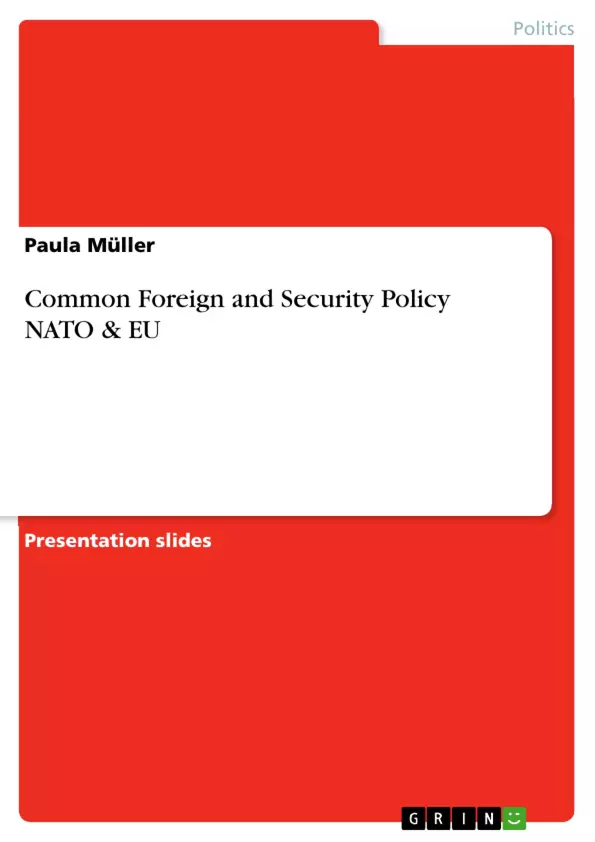Powerpoint-Präsentation zu folgenden drei Themen:
External Relations of the EU, The CFSP explained, Advantages & Disadvantages of the cooperation between EU & NATO.
Inhaltsverzeichnis (Table of Contents)
- External Relations of the EU
- The CFSP explained
- Advantages & Disadvantages of the cooperation between EU & NATO
Zielsetzung und Themenschwerpunkte (Objectives and Key Themes)
This document provides an overview of the European Union's external relations, specifically focusing on the Common Foreign and Security Policy (CFSP) and its cooperation with NATO. It explores the advantages and disadvantages of this collaboration, examining key areas of activity and the shared goal of promoting security and stability.
- The role of the CFSP in the EU's external relations
- Cooperation between the EU and NATO in areas like crisis management and capability development
- The advantages and disadvantages of this cooperation
- Key threats addressed by the EU and NATO
- Areas of activity and the shared goal of promoting security and stability
Zusammenfassung der Kapitel (Chapter Summaries)
- The first chapter covers the EU's external relations, highlighting key areas such as supranational and international agreements, external trade, foreign and security policy, enlargement, development policy, and human rights.
- The second chapter focuses on the CFSP, explaining its role as a cornerstone of the EU's foreign policy and outlining its three main pillars: the Common Foreign Security Policy, emergency assistance, and foreign policies relating to third countries and international organizations.
- The third chapter delves into the cooperation between the EU and NATO. It highlights the historical evolution of their partnership, starting with the 1992 establishment of the Western European Union (WEU) as the body responsible for the CFSP and culminating in the 2003 Berlin-plus agreement, which laid the foundation for their current collaboration.
- The fourth chapter examines the five main threats that the EU and NATO jointly address: terrorism, ABC-weapons, regional conflicts, failed states, and organized crime.
- The fifth chapter explores the areas of activity where the EU and NATO collaborate, including civilian crisis management, conflict prevention, development assistance, enlargement, the European Neighborhood Policy, and peacekeeping operations. It also emphasizes the shared goal of the two organizations: working side-by-side in crisis management, capability development, and political consultations.
Schlüsselwörter (Keywords)
This document focuses on the European Union's Common Foreign and Security Policy (CFSP), its cooperation with NATO, and the challenges they jointly address. Key concepts include crisis management, capability development, political consultations, and the threats of terrorism, ABC-weapons, regional conflicts, failed states, and organized crime. This overview provides a comprehensive understanding of the EU's external relations and the crucial role of the CFSP in promoting security and stability globally.
- Quote paper
- Paula Müller (Author), 2014, Common Foreign and Security Policy NATO & EU, Munich, GRIN Verlag, https://www.grin.com/document/450802



